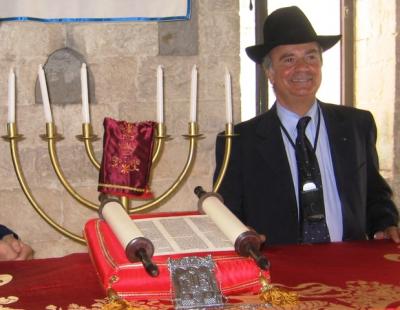
Avraham Zecchillo, brought daylight to Italian crypto-Jews

Avraham Zecchillo, who revived the 750-year-old synagogue in the southern Italian port of Trani, Puglia region (see map), centuries after it had been closed, died on June 10. Zecchillo was a descendant of the Bnei Anusim—southern Italy's hidden Jews or "marranos"—who he said had lived in Trani "forever, for thousands of years." After living in Israel and serving in the IDF, he returned to Trani to revive the Jewish presence in the area and reopen the city's Scolanova (Italian for "new school") synagogue, in the historic giudecca or old Jewish quarter.
Only two media outlets seem to have noted Zecchillo's passing—the local Giornale di Trani of that day, and the Jerusalem Post of June 16, in a column by Michael Freund, chairman of Shavei Israel, an organization "which assists 'lost Jews' seeking to return to the Jewish people." Freund provides some historical background on Trani's Bnei Anusim:
The Jewish presence in southern Italy is well over 1,000 years old. After the Muslim invasion of Sicily in the late ninth and early 10th centuries, the community was bolstered by new arrivals, who turned Trani and the surrounding region of Puglia into a thriving Jewish center.
The traveler Benjamin of Tudela, who visited in 1166, wrote that “Trani is located on the sea, where all the pilgrims gather to go to Jerusalem, for the port is a convenient one. A community of about 200 Israelites is there, at their head being Rabbi Elijah, Rabbi Nathan the Expounder, and Rabbi Jacob. It is a great and beautiful city.”
Among the Talmudic scholars it produced are Rabbi Moshe of Trani (known as the Mabit), and Rabbi Isaiah of Trani, considered one of the outstanding sages of the 13th century.
It was during this period, thanks to the benevolent rule of King [actually Holy Roman Emperor—NJR] Frederic II, that Trani’s Jews flourished commercially and spiritually, building impressive synagogues such as the Scolanova.
But a few decades after Frederic’s passing, a wave of anti- Semitism struck without mercy, and by 1290 the Jews of Puglia had been hit hard by persecution and forced conversions.
Trani’s four synagogues, including the Scolanova, were confiscated and later transformed into Catholic churches, their Jewish symbols stripped away and their former congregants compelled to practice Judaism in secret. These crypto-Jews were known by the Italian word neofiti, and they suffered from discrimination at the hands of their neighbors.
Nonetheless, in the 15th century, there was a brief revival of Jewish life in Puglia after Jews expelled from Spain in 1492 settled in the area.
But when the Spanish monarchs captured the region in 1510, a series of further expulsions began, and by 1541 the Jews were all but forced to leave.
That, however, was not the end of Trani’s Jewish story.
Thankfully our people have long memories, which is one of the qualities that have kept us alive throughout the millennia.
And so it was that six years ago, in an unusual move, the Scolanova synagogue was at last returned to the Jewish people. This was largely thanks to the efforts of Francesco Lotoro, a local professor of music who prodded the authorities to restore the building to its rightful owners.
Lotoro and his wife, who are themselves Bnei Anusim, underwent formal conversion to Judaism by Italy’s Chief Rabbinate several years ago.
Although Trani's authorities would not allow removal of the bell-tower that had been added to the Scolanova during its years as a Catholic church, Zecchillo stealthily removed the cross from the top of the tower and had it replaced with a Star of David. Zecchillo had been the Scolanova's caretaker, and seemingly entire congregation, in recent years, although Freund writes:
Recently, Shavei Israel, the organization I chair, partnered with Naples Chief Rabbi Shalom Bahbout and the Union of Italian Jewish Communities to assist the Bnei Anusim of southern Italy, a growing number of whom wish to return to the Jewish people.
But Freund's organization, Shavei Israel, does not merely assist crypto-Jews in "returning to the Jewish people," but in "returning" to Israel—essentially, treating them as demographic cannon fodder for the Jewish state. It is interesting to note that Zecchillo's journey took him in the other direction—from Israel back to a diasporic homeland, retuning an openly Jewish presence to a place where it had been purged for centuries.
